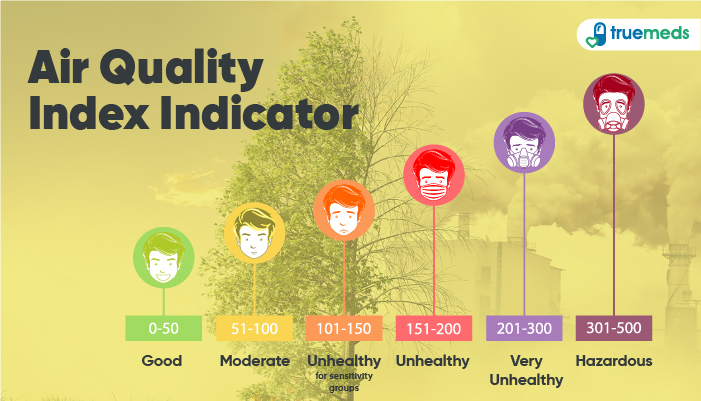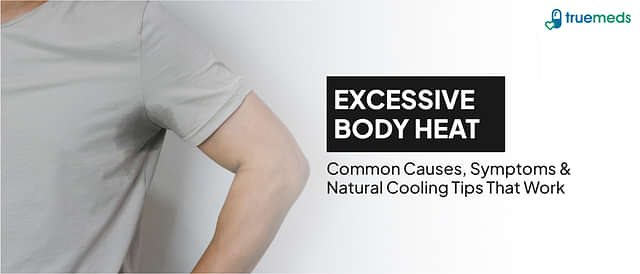Air Pollution- Its Impact On Health and Pollution Reduction
Last updated on : 21 Apr, 2025
Read time : 7 min
The atmosphere in which we breathe impacts our health in many ways. It is an indispensable part of the living system that helps generate energy in the body, promotes the growth and generation of new cells, and supports the normal function of the immune system. Polluted air can lead to increased risk of various diseases such as asthma, chronic obstructive pulmonary disease, stroke, lower respiratory infections, heart diseases and more. Thus, clean air has now become a necessity for good health and life. The air quality index is indicative of the extent to which the air is free of pollution.
Clean air translates to a good air quality index. The air quality index is a scale numbered from 0-500. The scale of 0-500 is split into six categories, explaining the concern level. The levels are given specific colours, which help people know quickly the extent of air pollution.
Considering the impact of air on our daily lives, let’s delve deeper to understand the components that determine the pollution in the air and, finally, the impact on the environment and human beings’ health and policies to reduce air pollution.
What is the air quality index (AQI)? How do you understand the colour code?
The air quality index is “an index for determining the daily air quality. It tells us if we are breathing and living in clean surroundings and the impact on our health, which we should be aware of. The impact of air pollution can range from short-term illnesses to long-term health concerns.
The AQI scale runs from 0-500. In general, the higher the scale number, the greater the extent or intensity of air pollution. For example, a 50 reading on the scale represents good quality air that is free of air pollutants and easy to breathe, while a reading of 300 indicates hazardous air quality.
Colour code versus air pollution
The air quality index is divided into six different colours to help us understand air quality. Look at the image below, a simple colour table explaining the level of concern through colours (green, yellow, orange, red, purple and maroon) versus air quality index value (0-500).

Now, we now know what is good and not-so-good about air quality. Let us also look at the reasons that make the air polluted.
What is air pollution, and what are the major air pollutants?
Air pollution is contamination of the environment, including indoor and outdoor, by physical, chemical and biological agents. The major contributors to air pollution are particulate matter, carbon monoxide, sulphur dioxide, nitrogen dioxide, and ozone.
As per WHO, almost all the population (99%) breathes air beyond the air quality guidelines set by WHO as it contains high levels of pollutants. Low-middle-income countries suffer the most due to air pollution.
Health effects due to air pollution and who is at risk
Every pollutant has a specific impact on the health of an individual.
Find here a comprehensive list of health hazards due to major air pollutants. This list will help you to understand the AQI in your area; AQI is available easily through different apps or weather forecasts.
- Ground-level Ozone: It is formed by the interaction of sunlight and chemicals released from vehicles and industries. It is a major concern, mainly during summer. Children and people who stay outdoors for a long time are at greater risk. The respiratory system, including the lungs, is the most affected. It can aggravate asthma, reduce lung function, increase susceptibility to respiratory infections and cause itching, coughing and uncomfortable chest sensations.
- Particulate matter: It is composed of both liquid and solid droplets. It comes in two different sizes. Oversized particles are from grinding and crushing work, while small ones are from the combustion process; the tiny particulate matter is of more significant concern due to their ability to deposit in the respiratory system. Children, elderly with co-morbidities and people who are already suffering from lung, respiratory and cardiac diseases are most susceptible. It can aggravate asthma and cause the worsening of various lung and heart conditions.
- Carbon monoxide: It arises mainly from vehicular pollution. The most vulnerable people are pregnant women, the elderly, young children and patients with pre-disposed cardiac and respiratory diseases.
- Sulphur dioxide: It is released mainly from the coal and oil industries during smelting. Children and adults with asthma who are mostly outdoors are most affected.
- Nitrogen dioxide: The nitrogen dioxide pollutants are formed due to a reaction between nitric oxide and oxygen. Both children and respiratory disease patients are affected. It can cause respiratory symptoms like coughing, wheezing and shortness of breath.
The effect of air pollution is not restricted to health alone; the impact of air pollution also results in reduced visibility conditions referred to as soot and smog.
- Smog: It occurs when emissions from combusting fuels interact with sunlight. Smog can irritate the throat and eyes and damage the lungs. It is seen to be more severe in children, the elderly, and people who work outdoors for long hours.
- Soot: It is characterised by particulate matter made up of tiny particles of chemicals, soil, smoke and dust carried in the air.
The hazy conditions cause health problems similar to significant air pollutants but also create environmental issues like acid rain formation.
Air pollution is harmful to human beings in various ways. Clean air is essential for living a healthy life. It is also essential to loweri the risk of cardiovascular disease and diabetes, slowing the ageing process, and improving mental health as well.. Therefore, it helps by achieving overall well-being.
How do we tackle air pollution?
- Recycle and reuse- it helps conserve resources and controls air pollution.
- Reduce the use of plastic bags- it takes a very long time to decompose, hence contributing to the pollution of the environment.
- Reducing forest fires and smoking reduces air pollution by less smoke and particles.
- Using filters for chimneys
- Implementing afforestation- It will help by increasing oxygen levels in the air and improving the environment.
Conclusion
The air quality index (AQI) helps us in regulating air pollution. AQI has a unique colour code system to explain air pollution. The colour code also tells the various levels of each air pollutant, such as carbon monoxide, sulphur dioxide, nitrogen dioxide, ozone, and particulate matter. Each air pollutant is responsible for its impact on human health and damages the body system, especially the respiratory system. They also cause reduced visibility through the formation of smog and soot. Air pollution is a continuously growing concern around the world. WHO also monitors air pollution and has developed policies and interventions to tackle this problem. It is high time that we start working on improving AQI for a healthy air and a healthy future.
The effects of air pollution are on the respiratory, cardiovascular, reproductive and neurological systems. It increases the risk and is also a cause of diseases, including cancer, lung diseases, heart diseases and immune system disorders.
Yes, air pollution is a worldwide problem. As per WHO, almost all the population (99%) breathes air beyond WHO safe limits and contains high levels of pollutants. Low-middle-income countries suffer the most due to air pollution.
The air quality index is an index for telling the daily air quality. It tells us if we are breathing and living in clean surroundings. The AQI scale runs from 0-500. In general, the higher the scale number, the greater the extent or intensity of air pollution. For example, a 50 reading on the scale represents good quality air that is free of air pollutants and easy to breathe, while a 300 scale indicates hazardous air quality.
Air pollution is contamination of the environment, including indoor and outdoor, by physical, chemical and biological agents.
References
- Air pollution: Everything you need to know. (n.d.). Be a Force for the Future | NRDC. https://www.nrdc.org/stories/air-pollution-everything-you-need-know#control
- AQI basics. (2023, August 15). AirNow.gov. https://www.airnow.gov/aqi/aqi-basics/
Disclaimer
Our healthcare experts have carefully reviewed and compiled the information presented here to ensure accuracy and trustworthiness. It is important to note that this information serves as a general overview of the topic and is for informational purposes only. It is not intended to diagnose, prevent, or cure any health problem. This page does not establish a doctor-patient relationship, nor does it replace the advice or consultation of a registered medical practitioner. We recommend seeking guidance from your registered medical practitioner for any questions or concerns regarding your medical condition.
Popular Articles
Recommended Articles
Recent Articles
Top-Selling Medicines:
...View more
Top-Selling OTC:
...View more
Company
About UsHealth ArticleHealth StoriesDiseases & Health ConditionsAll MedicinesAll BrandsNeed HelpFAQSubscribe
Registered Office Address
Grievance Officer
Download Truemeds

Contact Us
Our customer representative team is available 7 days a week from 9 am - 9 pm.
v3.7.12
Our Payment Partners


























































